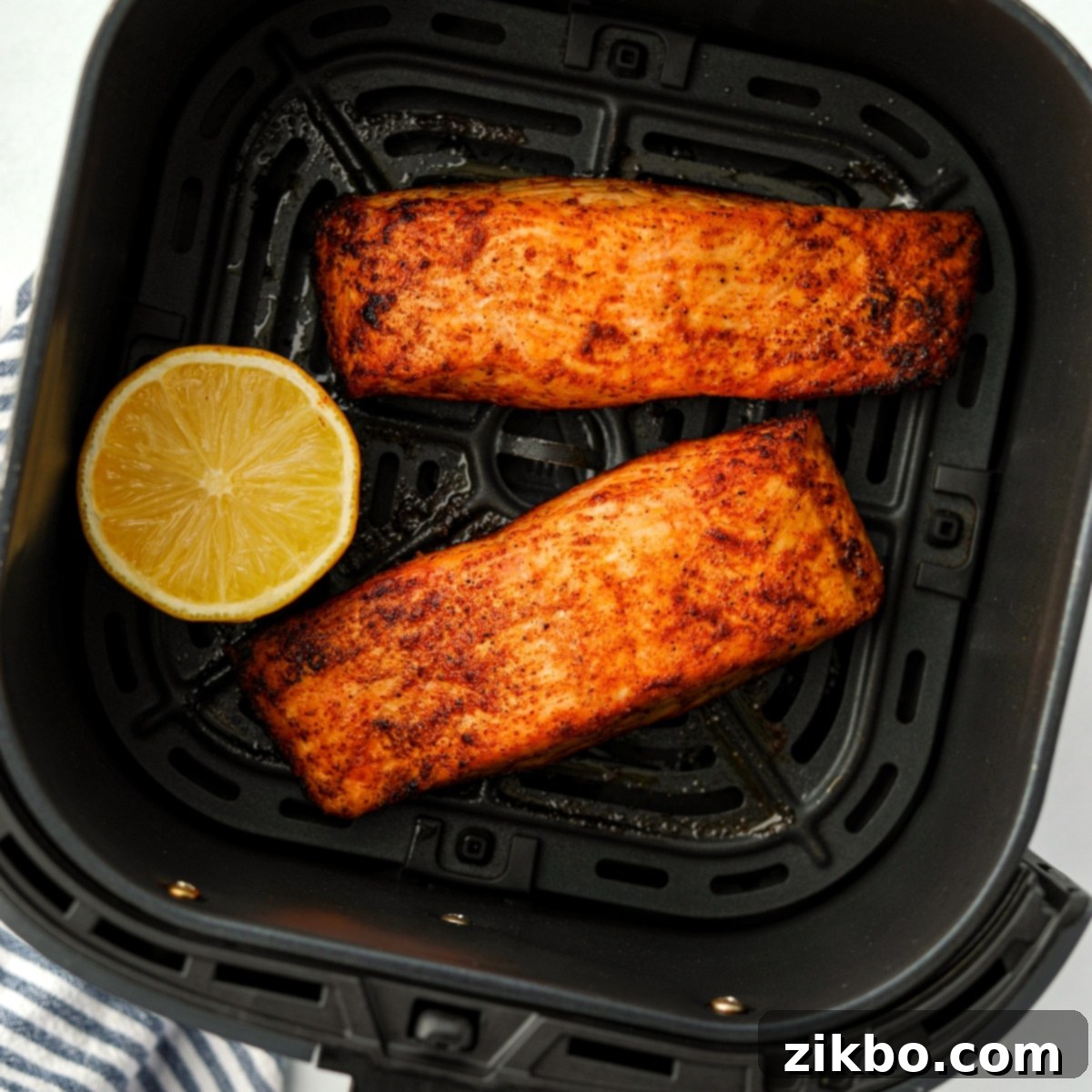Easy Air Fryer Frozen Salmon: Perfect Flaky Fillets Every Time (No Thaw Required!)
Are you a busy individual who still wants to enjoy healthy, delicious meals without the fuss? This Air Fryer Frozen Salmon recipe is your ultimate dinnertime solution! Forget about remembering to thaw your fish hours in advance – this method allows you to cook beautifully flaky, tender salmon fillets straight from the freezer. It’s a game-changer for anyone seeking a quick, nutritious, and incredibly simple meal.
Whether you’re planning a last-minute weeknight dinner or looking for an efficient way to meal prep a healthy protein for the week ahead, the air fryer transforms frozen salmon into a culinary delight. Prepare to be amazed by how easy and delicious perfectly cooked salmon can be, even on your busiest days.
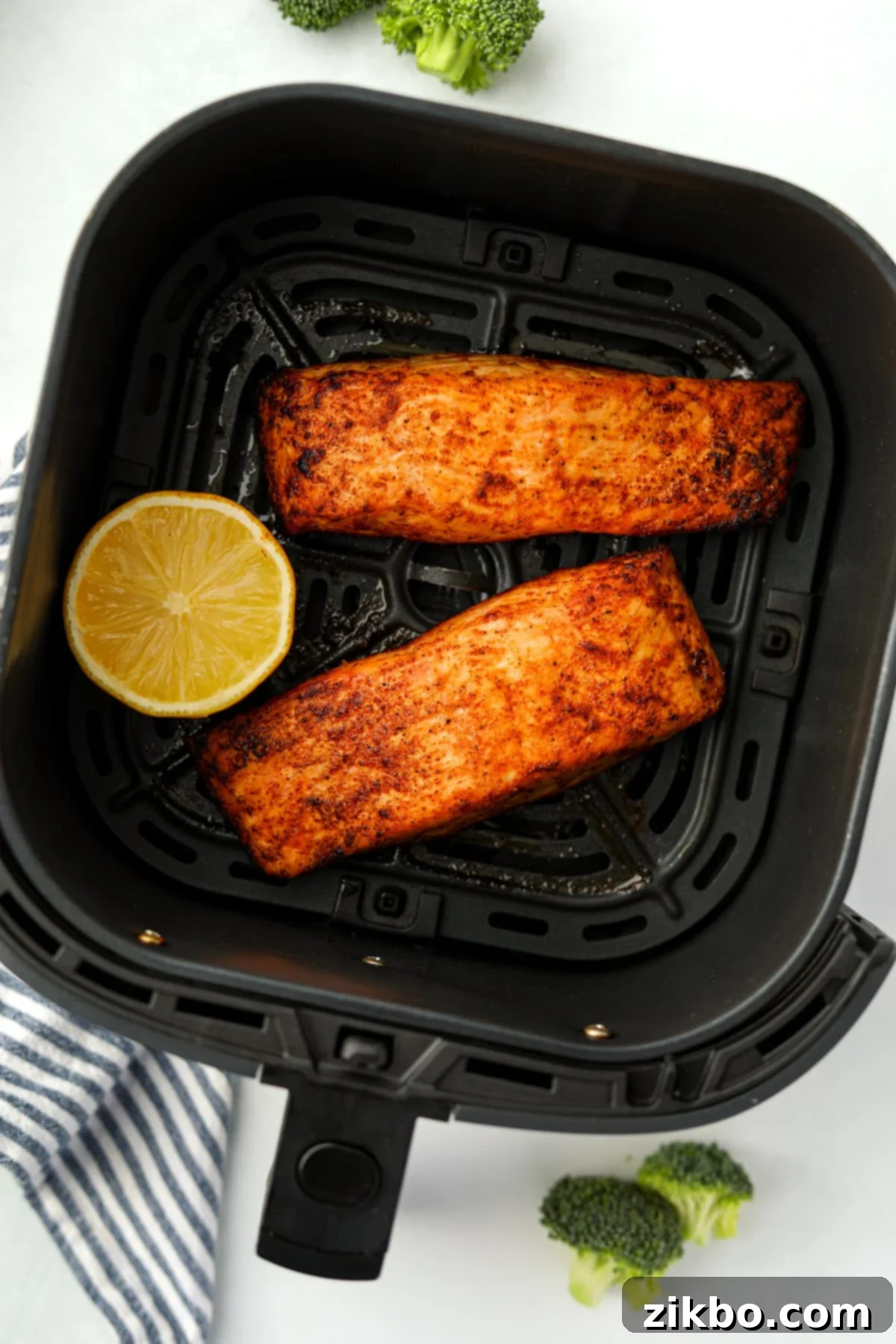
This recipe for air fryer frozen salmon has truly become one of my favorite dinnertime hacks. Yes, you read that right – straight from frozen! Life gets hectic, and sometimes just remembering to plan dinner feels like a monumental task, let alone taking something out to thaw. This method has been an absolute lifesaver for my busy household, ensuring a healthy and satisfying meal is always just minutes away. I’m confident it will become a staple in your kitchen too!
Pair it with quick steamed vegetables, a fresh green salad, or some fluffy Instant Pot rice, and you have a complete, wholesome meal ready to enjoy. It’s the easiest way to ensure you’re eating well, no matter how packed your schedule is.
Why You’ll Love This Air Fryer Frozen Salmon Recipe
Discover the myriad reasons why this air fryer frozen salmon recipe will quickly become your new favorite:
- Perfectly Cooked Every Time: Say goodbye to dry, overcooked salmon. The air fryer creates an incredible environment for cooking fish, resulting in perfectly flaky, tender, and juicy salmon with a slightly crispy exterior. You’ll achieve restaurant-quality results consistently.
- No Need to Thaw: This is the ultimate convenience! Forget to plan dinner? No problem. Simply grab your salmon fillets directly from the freezer and get cooking. This dramatically cuts down on meal prep time and stress, making healthy eating accessible on even the busiest weeknights.
- Effortlessly Customizable: While we provide a tried-and-true seasoning blend that highlights the salmon’s natural flavor, this recipe is a blank canvas for your creativity. Easily swap out the spices for your favorite herbs, rubs, or marinades to create an entirely new flavor profile every time.
- Healthy and Nutritious: Salmon is packed with Omega-3 fatty acids, high-quality protein, and essential vitamins and minerals. Cooking it in the air fryer uses minimal oil, making it an incredibly healthy option that supports your well-being.
- Quick and Easy Cleanup: The air fryer typically contains any mess, leading to fewer pots and pans to wash. Lining your air fryer basket with parchment paper (if suitable for your model) can make cleanup even faster.
- Versatile for Meal Prep: Cook a batch of these salmon fillets at the beginning of the week, and you have a ready-to-eat protein for salads, wraps, or as a main component for various meals throughout your busy week.
Essential Ingredients for Your Frozen Salmon
You’ll be delighted to find that preparing delicious air fryer frozen salmon requires just a few simple ingredients, most of which you likely already have on hand. Quality ingredients ensure a flavorful and satisfying meal every time.

- Frozen Salmon Fillets: The star of our dish! Look for high-quality, individually quick-frozen (IQF) salmon fillets. These typically range in size from about 4-7 ounces per fillet. For best results and even cooking, we recommend preparing 2 fillets at a time in most standard air fryers. If you wish to cook a larger quantity, it’s best to work in small batches to avoid overcrowding the basket, which can lead to uneven cooking. We often find great quality frozen salmon at bulk stores like Costco.
- Olive Oil: A touch of olive oil helps the seasonings adhere to the fish and contributes to a beautiful, slightly crispy exterior. It also adds a lovely depth of flavor. If you prefer a more neutral taste or have a higher smoke point preference, avocado oil is an excellent alternative and works just as well.
- Lemon Juice: Fresh or bottled lemon juice provides a bright, acidic note that perfectly complements the richness of the salmon. It adds a zing that enhances the overall flavor profile. While highly recommended, if you don’t have any on hand, you can omit it or substitute with other acidic liquids like lime juice or a mild vinegar.
- Seasonings: Our classic blend is simple yet incredibly effective for creating a universally appealing flavor that lets the salmon shine.
- Garlic Powder: Adds a foundational aromatic flavor that pairs wonderfully with fish.
- Paprika: Contributes a subtle smoky sweetness and a beautiful reddish hue to the salmon.
- Salt: Essential for seasoning and bringing out the natural flavors of the salmon.
- Black Pepper: Provides a gentle warmth and a touch of piquant flavor.
Essential Tools and Equipment
To ensure a smooth and successful cooking experience, make sure you have these key kitchen tools:
- Air fryer: Any model will work, but cooking times may vary slightly based on wattage and basket size.
- Meat thermometer: Crucial for verifying the internal temperature of the salmon, ensuring it’s safely cooked to 145ºF (63ºC) without overcooking. This is the most reliable way to guarantee perfect doneness.
- Small Mixing Bowl & Brush: For preparing and applying the seasoning mixture evenly.
How to Cook Frozen Salmon in an Air Fryer: A Step-by-Step Guide
Cooking salmon has never been easier or more convenient! This simple air fryer recipe allows you to achieve perfectly cooked, flaky salmon even when starting from frozen, making it ideal for the busiest weeknights.
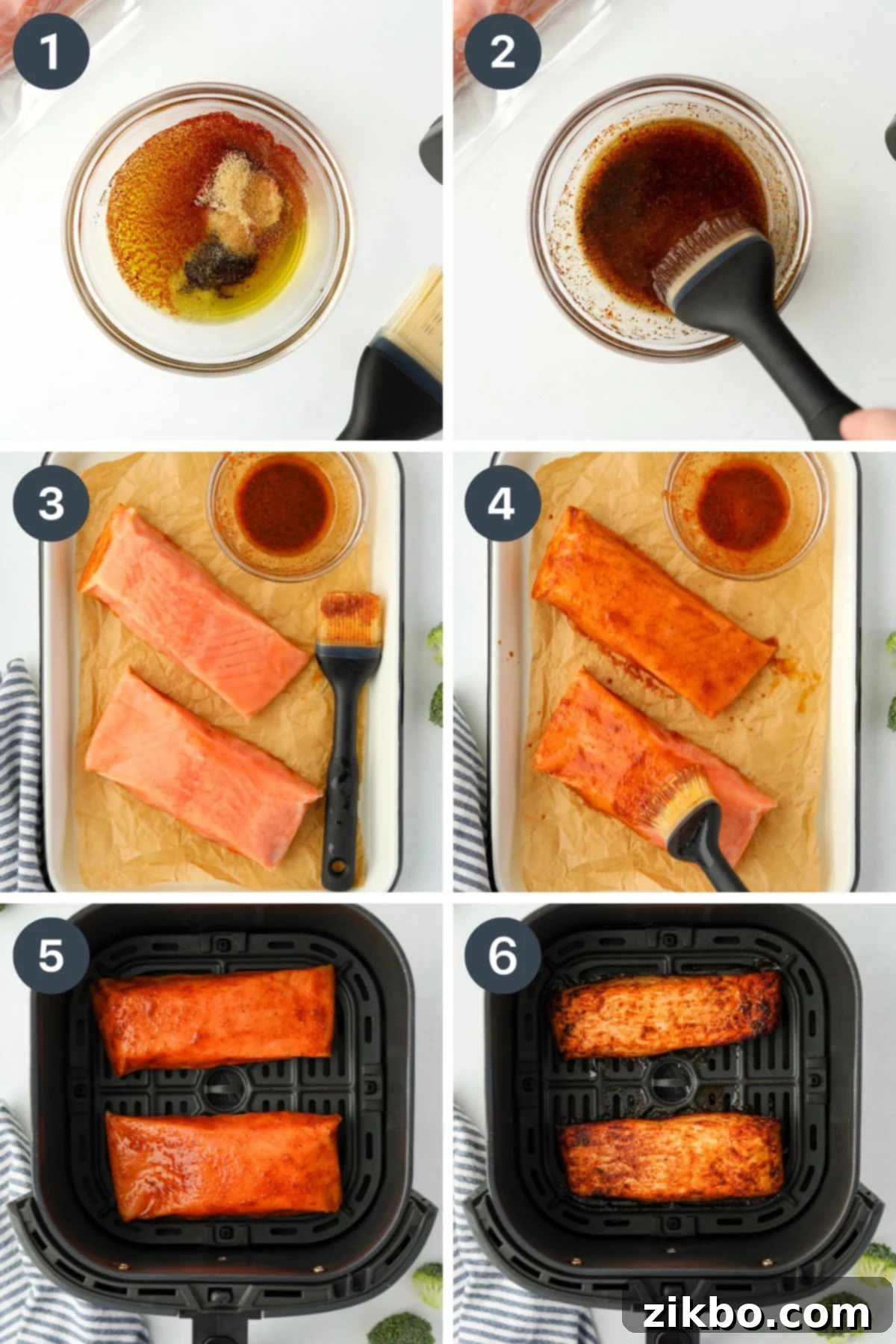
- Prepare the Seasoning Mixture: In a small bowl, combine the olive oil (or avocado oil), lemon juice, garlic powder, paprika, salt, and black pepper.
- 2 teaspoons olive oil (or avocado oil)
- 1 teaspoon lemon juice
- ½ teaspoon garlic powder
- ½ teaspoon paprika
- ¼ teaspoon salt
- ¼ teaspoon black pepper
- Whisk to Form a Paste: Stir the seasonings and oil together thoroughly until a thin, uniform paste forms. This ensures all the flavors are well integrated and easy to apply.
- Prepare Salmon for Seasoning: Gently remove the frozen salmon fillets from their individual packaging. Place them on a flat surface such as a plate, a piece of parchment paper, or a small tray. Ensure they are separated and not stuck together.
- Season the Fillets: Using a pastry brush or the back of a spoon, evenly brush all sides of each frozen salmon fillet with the prepared seasoned oil paste. Make sure they are well coated.
- Optional Flavor Boost: If time allows, let the seasoned salmon rest for 5-10 minutes before cooking. This allows the flavors to penetrate slightly and the surface to “dry brine,” which can lead to a slightly crispier exterior.
- Preheat Your Air Fryer: Preheat your air fryer to 390-400ºF (200-204ºC) for at least 3-5 minutes, or according to your air fryer’s manufacturer’s instructions. Preheating is crucial for achieving an even cook and a desirable crust. Once preheated, carefully place the seasoned salmon fillets into the air fryer basket. Position them skin side down (or where the skin would be if it has been removed). Avoid overcrowding the basket; cook in batches if necessary, allowing enough space for air to circulate around each fillet.
- Air Fry to Perfection: Cook the salmon at 390-400ºF for 14-17 minutes. The exact cooking time will depend on the thickness of your salmon fillets and the specific wattage of your air fryer. To ensure perfect doneness and food safety, use a meat thermometer to check the thickest part of the fillet. The salmon is fully cooked when it reaches a minimum internal temperature of 145ºF (63ºC).
- Note on Size: Larger or very thick pieces of salmon may require a slightly longer cooking time (perhaps 1-3 minutes more) or might benefit from being cooked closer to 400ºF. Smaller, thinner pieces may cook faster. Always rely on the internal temperature for accuracy.
- Do Not Flip: Unlike many air fryer recipes, it is best to avoid flipping salmon fillets during cooking. Fish is delicate and can easily flake apart. Cooking skin-side down helps protect the flesh and keeps the fillet intact, allowing it to cook beautifully without intervention.
- Serve Immediately: Once cooked through, carefully remove the salmon from the air fryer basket and serve warm with your chosen side dishes. Enjoy your incredibly easy and delicious air fryer frozen salmon!
Adjusting for Thawed Salmon Fillets
If you’ve remembered to thaw your salmon fillets ahead of time – perhaps you moved them from the freezer to the fridge the night before – you can absolutely still use this recipe! The preparation method remains the same: season your thawed salmon with the oil and spice mixture. However, you will need to significantly reduce the cooking time.
For thawed salmon fillets of average thickness, a cooking time of 7-10 minutes at 390-400ºF (200-204ºC) typically works well in most air fryers. As always, the most crucial step is to verify the internal temperature with a meat thermometer. Ensure the thickest part of the fillet reaches 145ºF (63ºC) to confirm it’s safely cooked and perfectly moist inside. Adjust cooking time as needed based on the fillet’s thickness and your air fryer’s efficiency.
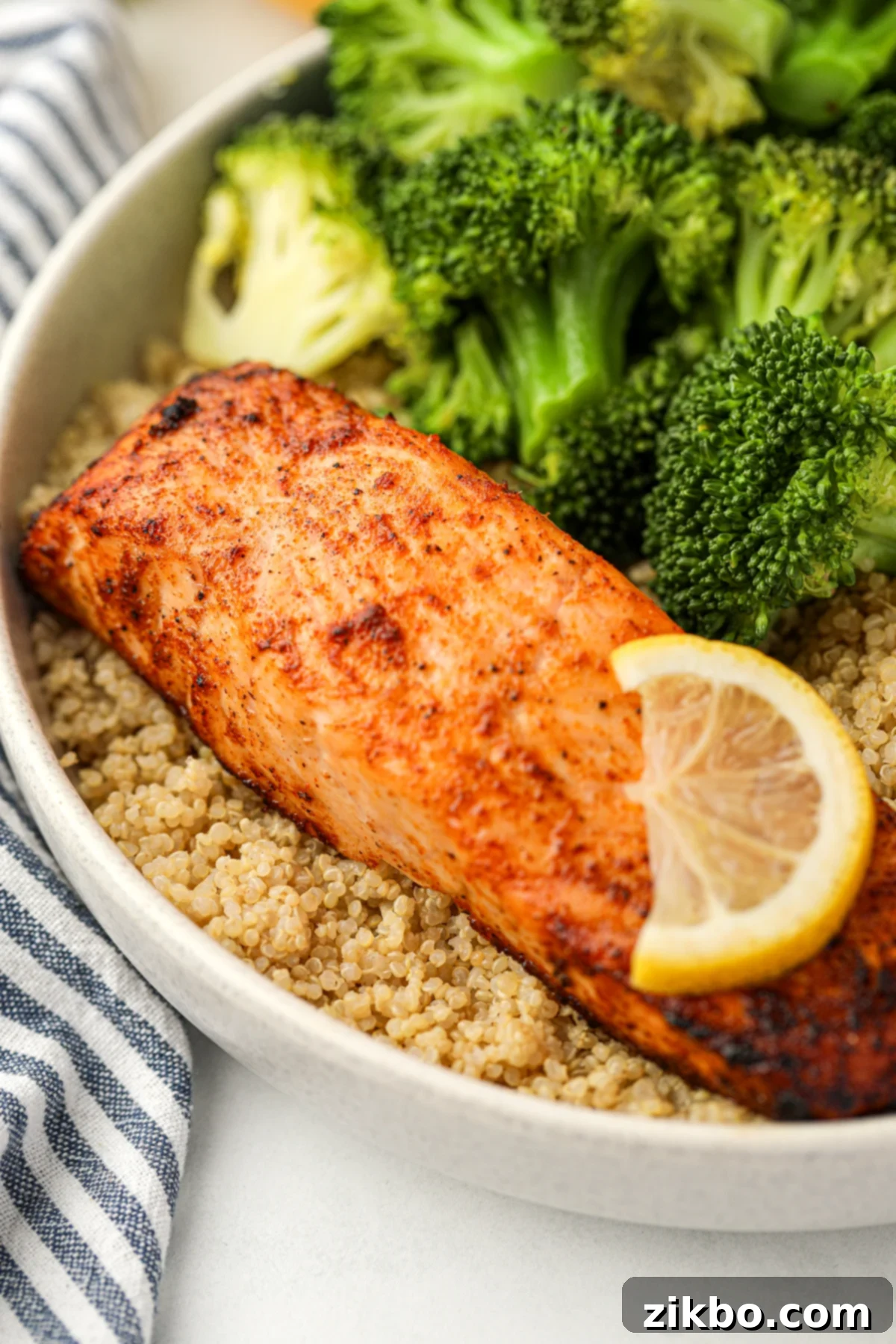
Delicious Side Dish Pairings for Your Air Fryer Salmon
Air fryer salmon, with its simple seasoning and perfect texture, is incredibly versatile and pairs beautifully with a wide array of side dishes. Here are some fantastic suggestions to complete your meal:
- Rice: From classic white or brown rice to flavorful pilafs, rice provides a comforting and absorbent base for the salmon’s juices.
- Quinoa: A protein-rich and gluten-free grain, quinoa offers a nutty flavor and satisfying texture.
- Couscous: Light and fluffy, couscous is a quick-cooking grain that complements salmon without overpowering it.
- Cauliflower Rice: For a low-carb option, cauliflower rice is an excellent choice that absorbs flavors wonderfully.
- Steamed Vegetables: Simple and healthy, steamed broccoli, asparagus, green beans, or zucchini are fantastic for a quick side. Their fresh, crisp texture contrasts beautifully with the flaky salmon.
- Roasted Vegetables: Roasting brings out the natural sweetness of vegetables. Try Brussels sprouts, carrots, bell peppers, or a medley of root vegetables for a heartier side.
- Mashed Potatoes: Creamy mashed potatoes (or sweet potatoes!) are a classic comfort food pairing that everyone loves.
- Roasted or Baked Potatoes: Crispy roasted potato wedges or a simple baked potato with your favorite toppings make for a satisfying side.
- Noodles: A light pasta dish, perhaps tossed with a lemon-garlic sauce, can be a delightful accompaniment.
- Cooked Greens: Sautéed spinach, kale, or Swiss chard with a hint of garlic and lemon adds a nutritious and flavorful component.
- Fresh Salads: A crisp green salad with a light vinaigrette, or a more substantial grain-based salad, provides a refreshing contrast and adds texture.
Storing and Reheating Leftover Salmon
Should you be lucky enough to have any leftover air fryer salmon – which isn’t always a guarantee once your family tastes it – proper storage is key to maintaining its quality and safety. Promptly transfer any cooled salmon leftovers to an airtight container and store them in the refrigerator. It will keep well for up to 3-4 days, making it an excellent option for quick lunches or another effortless dinner later in the week.
When you’re ready to enjoy your salmon again, you have a couple of reheating options. For a quick reheat, the microwave works well, but be careful not to overcook it, as this can dry out the fish. Heat in short bursts until warmed through. Alternatively, to help retain some of its original texture and crispness, reheat portions in an air fryer set to a lower temperature, around 300ºF (149ºC), for 5-7 minutes or until thoroughly heated through.
Top Tip for Leftovers: We firmly believe that leftover salmon is sometimes even better the next day! One of our absolute favorite ways to enjoy it is to flake the cooked salmon into small pieces. Mix it with warm rice, a splash of tamari (or soy sauce), a drizzle of sriracha for a little kick, and a dollop of creamy mayonnaise. This creates a deconstructed “spicy salmon bowl” that is absolutely delish and incredibly satisfying! It’s also fantastic flaked into salads or sandwiches.
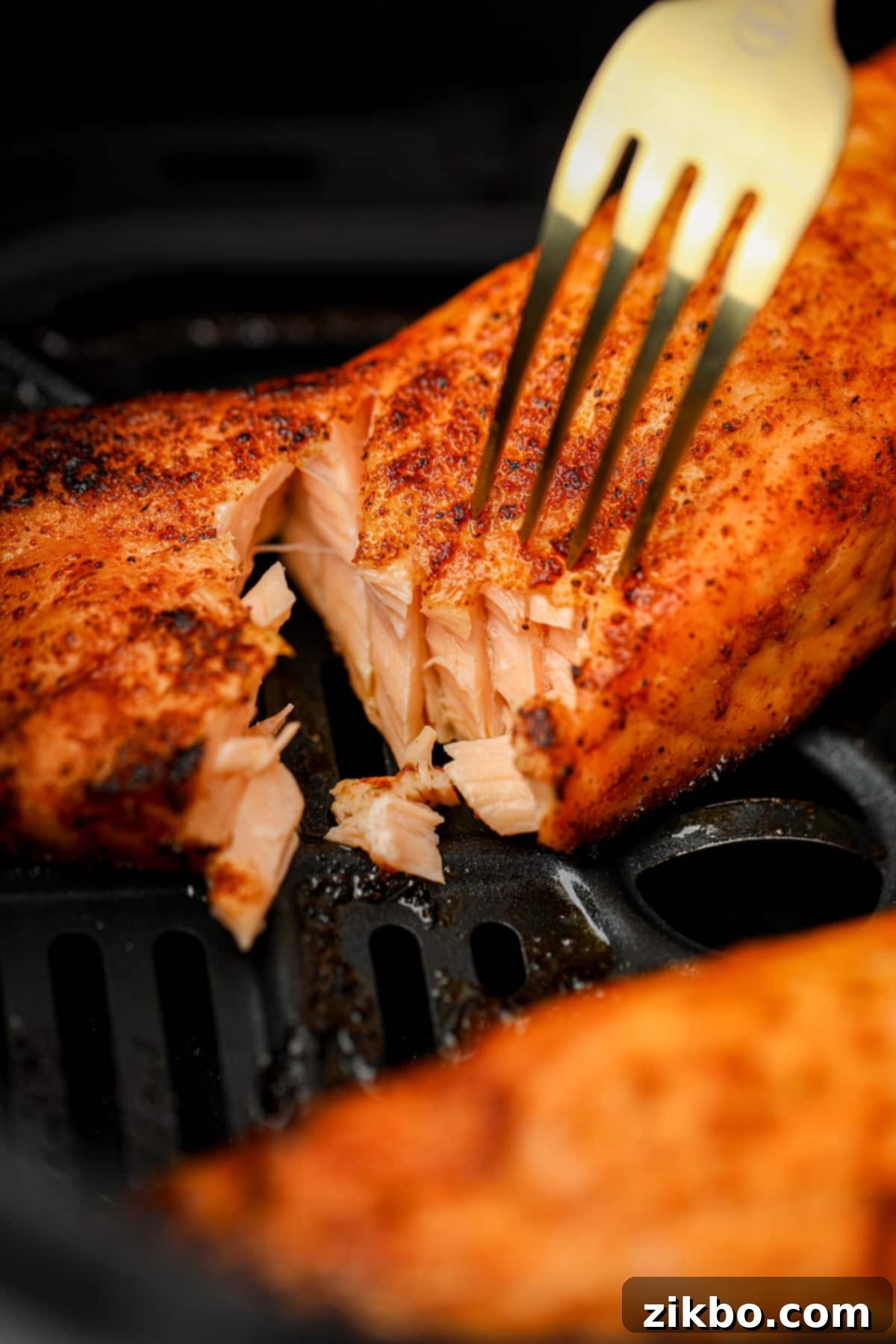
Expert Tips for Air Frying Frozen Salmon Like a Pro
Achieving perfectly cooked air fryer frozen salmon is simple, but a few expert tips can elevate your results from good to absolutely outstanding:
- Resist the Flip: This might go against your usual air frying instincts, but for salmon, it’s crucial: do NOT flip the fillets during cooking. Fish is inherently delicate and can flake apart easily. Cooking it skin-side down (or the side where the skin was removed) throughout the process helps to keep the fillet intact and prevents it from sticking. The circulating hot air in the air fryer will cook it evenly from all sides without needing to be turned.
- Embrace the 5-10 Minute Rest (Dry Brine): If you have an extra few minutes, allowing the seasoned salmon fillets to rest for 5-10 minutes before placing them in the air fryer can significantly enhance their flavor and texture. This brief “dry brine” allows the salt and seasonings to start working their magic, drawing out a little moisture from the surface, which can contribute to a slightly crispier exterior.
- Don’t Overcrowd the Basket: Air fryers work by circulating hot air around the food. If you pack the basket too tightly, the air cannot circulate effectively, leading to steamed (rather than air-fried) and unevenly cooked salmon. For best results, cook only 2-3 fillets at a time, ensuring there’s space around each piece. Cook in batches if preparing more.
- Always Preheat Your Air Fryer: Just like an oven, preheating your air fryer is essential for consistent results. It ensures that the salmon begins cooking immediately at the desired temperature, leading to better texture and more even cooking from the start. A good preheat usually takes 3-5 minutes.
- Trust Your Meat Thermometer: Visual cues can be misleading when cooking fish. The only sure way to know your salmon is perfectly cooked and safe to eat is by checking its internal temperature. Insert a meat thermometer into the thickest part of the fillet; it should register 145ºF (63ºC). This ensures juicy, flaky salmon every time.
- Experiment with Flavor Profiles: Don’t limit yourself to one seasoning blend! The neutral base of salmon makes it incredibly versatile. Try different seasonings and sauces to explore new flavors:
- Teriyaki: Brush with your favorite teriyaki glaze during the last few minutes of cooking.
- Hot Honey: A drizzle of hot honey adds a sweet and spicy kick.
- Dijon Mustard: A thin layer of Dijon mustard before seasoning adds a tangy depth.
- Lemon Dill: A classic pairing, fresh dill and extra lemon slices enhance the natural fish flavor.
- Cajun/Blackened: For a spicy, robust flavor, use a good quality Cajun seasoning.
Smart Substitutions for Your Air Fryer Salmon
This recipe is very flexible, allowing for easy substitutions to match your pantry, dietary needs, or flavor preferences:
- Olive Oil: If olive oil isn’t your preference or you’re looking for an alternative, avocado oil is an excellent swap. It has a high smoke point and a neutral flavor that won’t overpower the salmon. Other neutral oils like grapeseed or canola oil could also work.
- Lemon Juice: While highly recommended for its bright flavor, lemon juice can be omitted if you don’t have it. For a different acidic kick, consider lime juice, rice vinegar, or even a splash of apple cider vinegar. Each will impart a slightly different but equally delicious flavor.
- Salmon: This seasoning blend isn’t just for salmon! You can easily use it on other types of fish fillets, such as cod, halibut, or tilapia, or even on chicken breasts or thighs. Remember that cooking times and internal temperatures will vary for different proteins. Always cook all types of food to the minimum internal temperature recommended by the USDA to ensure safety.
- Seasonings: The garlic powder, paprika, salt, and pepper blend is a great starting point, but feel free to customize it! Swap it out entirely for your favorite seasoning blends.
- For a bright, zesty flavor, a generous sprinkling of lemon pepper seasoning makes for the most delicious lemon pepper salmon.
- If you crave a little heat and bold flavor, Cajun seasoning is another fantastic option that creates a wonderful crust.
- Other great choices include Italian seasoning, Old Bay seasoning, or a simple mix of onion powder and dried herbs.
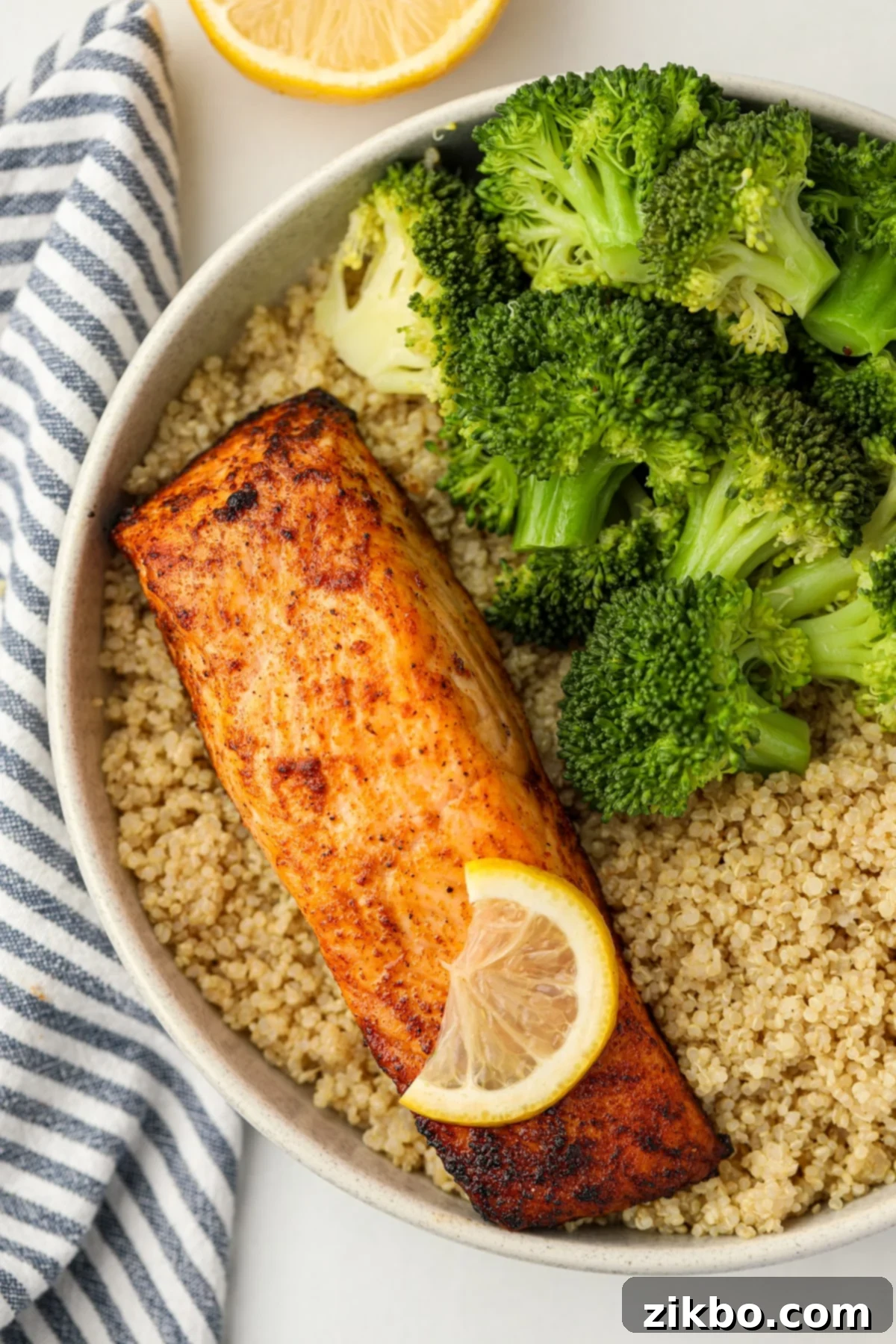
Frequently Asked Questions (FAQ) About Air Fryer Frozen Salmon
Here are answers to some common questions you might have about cooking frozen salmon in your air fryer:
- Can I cook more than two fillets at once? While this recipe works best with 2 fillets for even cooking, you can cook more if your air fryer basket is large enough to accommodate them in a single layer without overcrowding. If not, it’s best to cook in batches. Overcrowding can lead to steaming instead of air frying, resulting in less crispy and unevenly cooked fish.
- Should I leave the skin on or take it off? This is a matter of preference! Salmon skin, when cooked crisply, is delicious and adds flavor. If you prefer crispy skin, leaving it on and placing the fillet skin-side down in the air fryer basket is ideal. If you don’t enjoy the skin, it’s generally easier to remove it after cooking, as it helps protect the delicate flesh during the cooking process.
- How do I know if my salmon is cooked through? The most accurate way is to use a meat thermometer. Insert it into the thickest part of the fillet; it should read 145ºF (63ºC). Visually, cooked salmon will be opaque throughout and will flake easily with a fork.
- What if my salmon fillets are very thick or very thin? Adjust cooking time accordingly. Very thick fillets (over 1-inch) might need an additional 2-5 minutes of cooking time, or you might cook them at the higher end of the temperature range (400ºF). Thinner fillets will cook faster, potentially in just 10-12 minutes. Always rely on the internal temperature for accuracy.
- Do I need to spray the air fryer basket with oil? This depends on your air fryer model and if your salmon has skin. If your basket is non-stick, you might not need to. For added assurance against sticking, especially if your salmon is skinless or your air fryer isn’t perfectly non-stick, a light spray of cooking oil can be beneficial. Alternatively, you can line the basket with air fryer-safe parchment paper (ensure it doesn’t block air circulation).
- Can I use fresh salmon with this recipe? Yes! If you use fresh (never frozen) or fully thawed salmon, follow the same seasoning steps. However, reduce the cooking time significantly to 7-10 minutes at 390-400ºF (200-204ºC), checking the internal temperature for doneness.
More Air Fryer Recipes to Explore
If you’re loving the convenience and delicious results from your air fryer, be sure to check out these other fantastic recipes:
- Air Fryer Chicken Bites
- Air Fryer Chicken and Vegetables
- Perfect Air Fryer Bacon
- Crispy Air Fryer Sweet Potato Cubes
More Delicious Salmon Recipes
- Sheet Pan Salmon and Veggies
- Air Fryer Salmon Bites
- Cilantro Lime Salmon
- Air Fryer Salmon Patties
If you loved this incredibly convenient and delicious recipe for air-fried frozen salmon, please let me know by leaving a 5-star review in the recipe card below or dropping a comment! Your feedback is incredibly valuable. You can also tag me on Instagram @dashfordinner and share your amazing culinary creations!
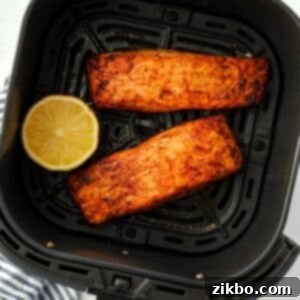
Air Fryer Frozen Salmon
Print
Pin
Rate
Ingredients
- 2 frozen salmon fillets approximately ¾ pound – 6 ounces each, ideally similar in thickness for even cooking
- 2 teaspoons olive oil or avocado oil for seasoning and crisping
- 1 teaspoon lemon juice (optional, fresh or bottled, for a bright flavor)
- ½ teaspoon garlic powder for aromatic depth
- ½ teaspoon paprika for color and subtle sweetness
- ¼ teaspoon salt or to taste, for seasoning
- ¼ teaspoon black pepper freshly ground preferred
Instructions
-
Preheat Air Fryer: Preheat your air fryer to 390ºF (200ºC) for at least 3-5 minutes, or according to your manufacturer’s instructions. This step is crucial for even cooking and a crispy exterior.
-
Prepare Salmon: Remove the frozen salmon fillets from their individual vacuum-sealed packaging and place them on a clean plate or cutting board.
-
Make Seasoning Paste: In a small bowl, combine the olive oil (or avocado oil), lemon juice (if using), garlic powder, paprika, salt, and black pepper. Whisk these ingredients together until they form a smooth, thin paste.
-
Season Salmon: Using a pastry brush, evenly brush both sides of each frozen salmon fillet with the seasoned olive oil paste. Ensure thorough coverage for maximum flavor. Note: If desired, you can allow the salmon to rest for 5-10 minutes after brushing to “dry brine” and enhance flavor penetration.
-
Place in Air Fryer: Carefully place the seasoned fillets, skin side down (or where the skin would have been if removed), in the preheated air fryer basket. Ensure the fillets are in a single layer and not overlapping to allow hot air to circulate freely. Cook in batches if necessary.
-
Cook from Frozen: Cook for 14-17 minutes at 390-400ºF (200-204ºC). Cooking time may vary based on fillet thickness and air fryer model. Do not flip the pieces during cooking, as salmon is delicate and can flake apart.
-
Check Doneness & Serve: Use a meat thermometer to ensure the thickest part of each piece of salmon reaches a minimum internal temperature of 145ºF (63ºC) for food safety and perfect doneness. Remove from the air fryer and serve immediately.
Notes
Internal temperature for perfect doneness: Salmon is safely and perfectly cooked through when it reaches a minimum internal temperature of 145ºF (63ºC) as measured by a meat thermometer inserted into the thickest part of the fillet.
Cooking thicker fillets: If your salmon fillets are particularly thick (over 1 inch), you might find it beneficial to cook them at the higher end of the temperature range, around 400ºF (204ºC). It’s also critical to only cook 1-2 fillets at a time to ensure even cooking and optimal air circulation. Always verify the internal temperature with a meat thermometer to guarantee they are cooked through, adding more time as needed.
Using thawed salmon: If you have thawed your salmon fillets beforehand (either fresh or previously frozen and thawed), you can still follow this recipe! Simply reduce the cooking time to 7-10 minutes at 390-400ºF (200-204ºC), again verifying the internal temperature for accuracy.
For crispy edges: If you enjoy a slightly crispier texture on your salmon, you can increase the heat to 400ºF (204ºC) for the entire cooking duration, or for the last 2-3 minutes of cooking. Keep a close eye on it to prevent overcooking.
Lemon pepper salmon variation: For a delightful lemon pepper salmon, simply swap out the listed garlic powder, paprika, salt, pepper, and lemon juice for a generous sprinkling of your favorite lemon pepper seasoning blend. This creates a zesty and vibrant alternative.
Nutrition
Please note that some of my blog posts here at Dash for Dinner may contain affiliate links. If you make a purchase through these links, I will get a small commission at no additional cost to you. Please see my Disclaimer for more information.
